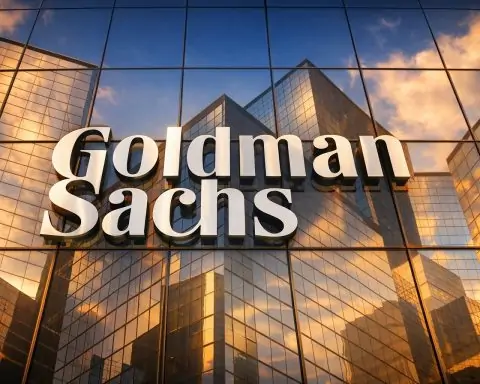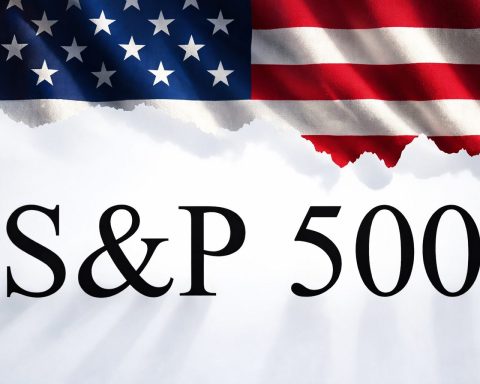- Two U.S. regional banks – Zions Bancorp and Western Alliance – revealed surprise bad loan losses and fraud issues this week, sparking a sell-off in bank stocks [1].
- Zions wrote off $50 million after discovering apparent fraud in two large loans, sending its shares plunging about 12% in one day, while Western Alliance fell over 10% amid a related fraud lawsuit [2]. Investment bank Jefferies also slid ~9% on fears of its exposure to a bankrupt auto lender [3].
- The market reaction was swift: the Dow Jones index fell nearly 400 points (~0.9%) and the S&P 500 about 1% on Thursday as credit fears overshadowed strong earnings [4]. Safe-haven assets surged – gold hit a record above $4,370/oz and Treasury yields sank to 2025 lows as traders bet on Federal Reserve rate cuts [5] [6].
- CNBC’s Jim Cramer argued that rising bad loans are “an early warning” that will pave the way for the Fed to ease policy, saying the situation “will make it easier for the Federal Reserve to cut interest rates” [7]. Indeed, futures markets now price in at least two Fed rate reductions by the end of 2025 [8].
- Experts are divided on whether these loan troubles are isolated blunders or signs of deeper issues. JPMorgan’s Jamie Dimon warned that “when you see one cockroach, there are probably more” lurking in loan portfolios [9], but bank executives insist the problems are contained one-offs [10].
Surprise Loan Frauds at Regional Banks Shake Confidence
Mid-sized banks shocked Wall Street this week with alarming disclosures of bad loans. Zions Bancorporation – a Utah-based regional lender – stunned investors by announcing a $50 million charge-off tied to two commercial loans that it says were compromised by fraud [11]. In an SEC filing, Zions reported “misrepresentations and contractual defaults” by the borrowers and moved to accelerate the loans to default and sue the guarantors [12] [13]. Western Alliance, a Phoenix-based peer, also revealed it is dealing with a fraudulent borrower, having filed a lawsuit back in August after the client allegedly used fake collateral [14] [15]. These back-to-back fraud bombshells amplified scrutiny of regional banks’ lending practices and risk controls, fueling concern that similar hidden problems could be lurking elsewhere [16] [17]. “Hidden credit stress” is how one Reuters report described the market’s mood – essentially investors wondering if this was just the first cockroach out of the pantry [18].
Investors reacted swiftly and harshly to the news. Zions’ stock plunged about 12–13% on Thursday, wiping out roughly $600–700 million in market value as shares fell into the upper-$40s (multi-month lows) [19]. Western Alliance tumbled around 10–11% the same day [20]. Even though Western Alliance wasn’t directly involved in Zions’ loans, the mere hint that another respected regional bank was caught up in a fraud scenario shook confidence across the sector [21]. “All these could be isolated incidents, but there are increasing concerns about souring loans and bad credit,” noted Neil Wilson of Saxo Markets – especially coming on top of other economic worries [22]. Any bank seen as exposed to risky or opaque loans quickly got punished: the S&P regional banking index sank roughly 5–6% in a day [23], and even larger institutions were not spared. For example, Jefferies Financial Group – which had disclosed hundreds of millions in exposure to the recent First Brands auto-loan bankruptcy – saw its shares slide about 9–10% as investors asked “what’s next?” [24]. In short, a wave of sell-first-ask-questions-later thinking hit the banking industry, despite many big banks reporting solid earnings just days earlier.
Credit Fears Spur Market Sell-Off and Safe-Haven Spike
The loan scare in the banking sector quickly cascaded into the broader market. On Thursday, U.S. stocks plunged amid credit jitters, abruptly reversing an early-session rally. The Dow Jones Industrial Average dropped roughly 410 points (about –0.9%), while the S&P 500 and Nasdaq each fell nearly 1% by the close [25] [26]. Notably, stocks had opened higher that morning on solid earnings, only to sink suddenly by afternoon as the bank fears gained traction [27]. Volatility spiked as well – the VIX “fear index” jumped ~20% to its highest level since May, reflecting the surge in investor anxiety [28]. Financial shares were the epicenter of the sell-off, but losses spread across most sectors, with over 80% of S&P 500 companies finishing down on the day [29]. “Credit concerns have put the market in de-risking mode,” one strategist observed, as traders rapidly cut exposure on any hint of trouble.
Investors rushed into safe havens amid the turmoil. Gold prices rocketed to an all-time high, briefly trading above $4,378 per ounce on Friday [30]. That marks about an 7–8% surge for gold this week – the metal’s largest weekly gain since 2008’s financial crisis [31] [32]. “It wouldn’t surprise me if gold hits $5,000 before it stops for air,” said Eren Osman of Arbuthnot Latham, noting the frenzied demand for the precious metal as a crisis hedge [33]. (He cautioned that such parabolic moves can reverse just as quickly – gold “could fall 20% next month” after this spike [34].) U.S. Treasurys also rallied hard as a flight-to-safety took hold. Benchmark bond yields, which move opposite prices, plunged to multi-year lows. The 10-year Treasury yield fell under 4.0% for the first time in 2025 [35], and the 2-year yield – highly sensitive to Fed policy expectations – dived to ~3.38%, its lowest level in three years [36]. “Safe-haven Treasuries rallied further… investors priced in at least two more rate cuts from the Fed this year,” Reuters reported [37]. In other words, markets are now betting that the Federal Reserve will have to cut interest rates sooner rather than later to stabilize the situation.
Global markets echoed the U.S. sell-off in a bout of risk aversion. By Friday, credit concerns had rippled worldwide: Japan’s Nikkei 225 slid about 1.6% and Hong Kong’s Hang Seng dropped ~2% [38]. In Europe, bank stocks fell in sympathy – the pan-European STOXX 600 index lost ~1.8%, led by a 2.7% plunge in the Euro Stoxx Banks index [39]. Major European lenders like Deutsche Bank and Barclays saw their shares skid over 5% [40]. “Signs of credit stress at U.S. regional lenders unnerved investors” globally, noted Reuters, as equities from London to Tokyo sank into the red [41] [42]. Meanwhile, classic safety plays like the Japanese yen and Swiss franc strengthened, and oil prices slumped to five-month lows on fears of slower growth [43]. The fact that a regional bank issue in the U.S. could flip market sentiment worldwide highlights how fragile confidence has become – and how sensitive investors are to any hint of financial stress in the system.
Fed May Ease Policy Sooner Amid Credit Worries
The upheaval in credit markets has also shifted expectations for U.S. monetary policy. Bond traders are suddenly signaling that the Federal Reserve might pivot to cutting rates much sooner than previously thought. Futures markets are now pricing in at least two quarter-point Fed rate cuts by the end of 2025 in the wake of this week’s banking scare [44]. The sharp drop in short-term Treasury yields reflects this sentiment – investors anticipate the Fed will need to cushion the economy and financial system, possibly beginning rate reductions within the next couple of Fed meetings. Prior to these events, Fed officials had been hinting at keeping rates high until inflation cools more. But the emergence of potential financial instability introduces a new factor that could tilt the Fed toward easing if contagion risks grow. “We finally have something to make the Fed nervous” about cutting rates, CNBC’s Jim Cramer remarked, referring to the banks’ bad loan troubles [45].
Prominent market commentators are openly discussing the prospect of Federal Reserve intervention. CNBC’s Jim Cramer, after Thursday’s market rout, argued that the surge in sour bank loans will force the Fed’s hand. This latest credit stress “will pave the way for the Federal Reserve to cut interest rates,” Cramer said, calling non-performing loans an “early warning signal” that it’s time for the central bank to ease up [46]. Lower borrowing costs would stimulate the economy and “make it easier for borrowers to avoid defaults,” he noted [47]. The logic is that if rising bad debts are threatening financial stability, the Fed may prioritize shoring up banks and credit over its inflation-fighting stance. Analysts also point out that falling interest rates could ironically help banks in the medium term – by reducing their funding costs and boosting the value of their bond holdings [48]. “Those falling yields and rising rate-cut bets could eventually help banks – easing funding costs and lifting bond values,” observed one report [49]. For now, Fed policymakers have not publicly signaled any imminent rate cut, but all eyes are on upcoming Federal Reserve meetings and speeches to see if the tone softens. The central bank’s challenge will be balancing its inflation objectives against these nascent risks to financial stability. If credit conditions continue to deteriorate, the case for at least a precautionary rate cut will strengthen – something virtually unthinkable just a few weeks ago.
“Cockroach” Warnings: Is More Trouble Lurking?
A central question now looms: are these regional bank loan debacles isolated blunders or the first signs of a wider credit problem? Thus far, bank executives and some analysts maintain that the Zions and Western Alliance incidents are specific one-offs rather than systemic issues. Zions’ CEO Harris Simmons, for instance, characterized the fraud loss as “an isolated situation,” noting that the bank hired outside counsel to conduct an independent review and ensure no broader weaknesses [50]. Western Alliance’s management likewise emphasized that their own fraudulent borrower case was already identified and contained, even pointing out that the bank’s total “criticized” (at-risk) loan assets actually decreased quarter-over-quarter [51]. In fact, many large banks seem relatively unworried at this stage – the top five U.S. banks collectively set aside the least loan-loss reserves in two years last quarter, signaling they aren’t bracing for a credit apocalypse [52]. These points bolster the view that the recent flare-ups, while scary, can be managed without sparking a 2008-style crisis. As one banking analyst noted, credit blow-ups “don’t always lead to something systemic” and often reflect individual issues [53]. From the industry’s perspective, the narrative is that a few bad actors and rogue loans slipped through the cracks, but overall loan quality remains solid.
However, many experts urge caution, warning that the back-to-back loan surprises could hint at broader vulnerabilities. JPMorgan Chase CEO Jamie Dimon raised eyebrows this week with a stark metaphor: “I probably shouldn’t say this, but when you see one cockroach, there are probably more,” he said, after JPMorgan itself revealed a $170 million loss tied to a failed borrower [54]. In other words, the veteran banker fears that one isolated bad loan could be a harbinger of others hidden in the shadows. Indeed, a string of recent corporate bankruptcies has already put Wall Street on alert. The collapse of Tricolor, a subprime auto lender accused of fraudulently pledging the same loans to multiple creditors, and the bankruptcy of auto-parts maker First Brands (which left a $2.3 billion hole of “vanished” assets), have exposed cracks in the system of lightly regulated “shadow banking” and private credit [55] [56]. “When things like that happen, my antenna goes up,” Dimon said of these off-balance-sheet lending fiascos [57]. Analysts note that banks dramatically increased business with non-bank lenders in recent years, which can be risky – loans made outside the traditional banking system aren’t subject to the same standards or oversight [58] [59]. As Argus Research’s Stephen Biggar observed, the latest surprises show “you can’t take credit quality for granted, and poor credit at one bank can drag down the group fast” [60]. In a similar vein, IG Markets strategist Tony Sycamore cautioned that while the recent issues seem contained, “where there is smoke, there is often fire,” and the emergency fixes that halted 2023’s bank panic may have left “a tinderbox for another banking flare-up” waiting to ignite [61] [62]. In short, skeptics fear that these “one-off” blunders could be the canary in the coal mine – early warnings of credit risks that have been building during the Fed’s rapid rate hikes.
Outlook: Cautious Optimism or Early Crisis Warning?
For now, Wall Street’s baseline view is that the banking hiccups, while jolting, can be contained so long as no new surprises emerge. Many analysts still have a cautiously optimistic outlook. “Unless deeper cracks spread, many believe the 2025 economic expansion – and stock rally – may bend but not break” despite the current jitters [63]. Notably, several bank analysts see the sell-off as potentially overdone if these issues truly prove isolated. Consensus ratings on Western Alliance and Zions have not been dramatically downgraded – in fact, Western Alliance still carries a “Strong Buy” consensus with an average price target ~30% above its current stock price, and Zions is rated “Hold” with a target implying ~25% upside from the latest levels [64]. These targets suggest that, if the fears subside, beaten-down bank stocks could rebound on the back of their still-solid fundamentals (both banks remain profitable and well-capitalized). It’s also worth noting that falling interest rates, paradoxically, might aid these banks by lowering their funding costs and boosting the value of loans and securities on their books [65]. In other words, the market turmoil has a silver lining: it has rapidly eased some financial conditions, which could help banks and borrowers if economic growth falters.
That said, the fragility of sentiment around banking and credit risk cannot be overstated. This week’s scare demonstrated how quickly confidence can evaporate – and how reactive markets are to any hint of trouble after the traumas of recent years. Some strategists warn that stocks could see another 5–10% pullback as investors digest these credit concerns and wait for clarity [66]. The fact that a single mid-sized lender’s mishap erased ~$100 billion in combined bank market value shows that nerves are still raw [67]. All eyes are now turning to upcoming earnings reports and guidance from regional banks for clues. Crucially, Zions and Western Alliance are due to report Q3 results in the coming days, which will give management a chance to detail the loan issues and reassure (or unnerve) investors. Those reports, along with commentary from regulators and the Fed, will help determine whether this episode was a contained anomaly or a warning sign of deeper credit problems. “If banks report solid results and no new surprises, it could go a long way to shoring up confidence,” noted analysts at TS2, whereas further trouble – another “cockroach” scuttling out – could renew the sell-off [68]. In essence, the market is on edge, bracing for either outcome.
Broader macro risks also loom in the background, complicating the picture. Prior to the bank scare, investors were already grappling with a laundry list of worries – sticky inflation, an ongoing U.S. government shutdown, and escalating U.S.–China trade tensions – all of which formed a “wall of worry” over the markets [69] [70]. The sudden bad-loan scare has now added yet another cloud to those stormy skies [71]. “There are increasing signs of storm clouds gathering over markets, with little relief from the building wall of worry” that now includes bad loans at U.S. regional banks, observed Richard Hunter of Interactive Investor [72]. In response, global investors have shunned risk and flocked to safe havens until some of these threats diminish [73]. Going forward, much will depend on whether the banking issues truly are one-offs. If no new “cockroaches” crawl out and the financial data stabilizes, sentiment could heal and focus may return to the economy’s resilience. In that scenario, the Fed might even manage a gentle easing cycle to spur growth without panic. But if more credit surprises emerge or losses mount, the feedback loop of fear could intensify – forcing policymakers’ hands and potentially marking an inflection point for the late-2025 market outlook. For now, the financial world is holding its breath. Everyone from Wall Street traders to Federal Reserve officials will be watching the coming days closely, hopeful that the worst is over – yet prepared, just in case this week’s drama was the first tremor of something larger.
Sources: Recent news reports and expert analyses from CNBC, Reuters, The Guardian, TS2 Tech, and others [74] [75] [76] [77]. All market data and stock moves are as of Oct. 17, 2025.
References
1. www.theguardian.com, 2. www.theguardian.com, 3. www.theguardian.com, 4. ts2.tech, 5. ts2.tech, 6. ts2.tech, 7. www.bitget.com, 8. ts2.tech, 9. ts2.tech, 10. ts2.tech, 11. www.theguardian.com, 12. ts2.tech, 13. ts2.tech, 14. www.theguardian.com, 15. ts2.tech, 16. ts2.tech, 17. ts2.tech, 18. ts2.tech, 19. ts2.tech, 20. ts2.tech, 21. ts2.tech, 22. www.reuters.com, 23. www.investopedia.com, 24. ts2.tech, 25. ts2.tech, 26. ts2.tech, 27. ts2.tech, 28. ts2.tech, 29. ts2.tech, 30. ts2.tech, 31. ts2.tech, 32. ts2.tech, 33. ts2.tech, 34. ts2.tech, 35. ts2.tech, 36. ts2.tech, 37. ts2.tech, 38. ts2.tech, 39. ts2.tech, 40. ts2.tech, 41. ts2.tech, 42. ts2.tech, 43. ts2.tech, 44. ts2.tech, 45. www.youtube.com, 46. www.bitget.com, 47. www.bitget.com, 48. ts2.tech, 49. ts2.tech, 50. ts2.tech, 51. ts2.tech, 52. ts2.tech, 53. ts2.tech, 54. ts2.tech, 55. ts2.tech, 56. www.theguardian.com, 57. www.theguardian.com, 58. www.investopedia.com, 59. www.investopedia.com, 60. ts2.tech, 61. ts2.tech, 62. ts2.tech, 63. ts2.tech, 64. ts2.tech, 65. ts2.tech, 66. ts2.tech, 67. ts2.tech, 68. ts2.tech, 69. ts2.tech, 70. ts2.tech, 71. ts2.tech, 72. ts2.tech, 73. ts2.tech, 74. www.theguardian.com, 75. ts2.tech, 76. ts2.tech, 77. www.bitget.com










